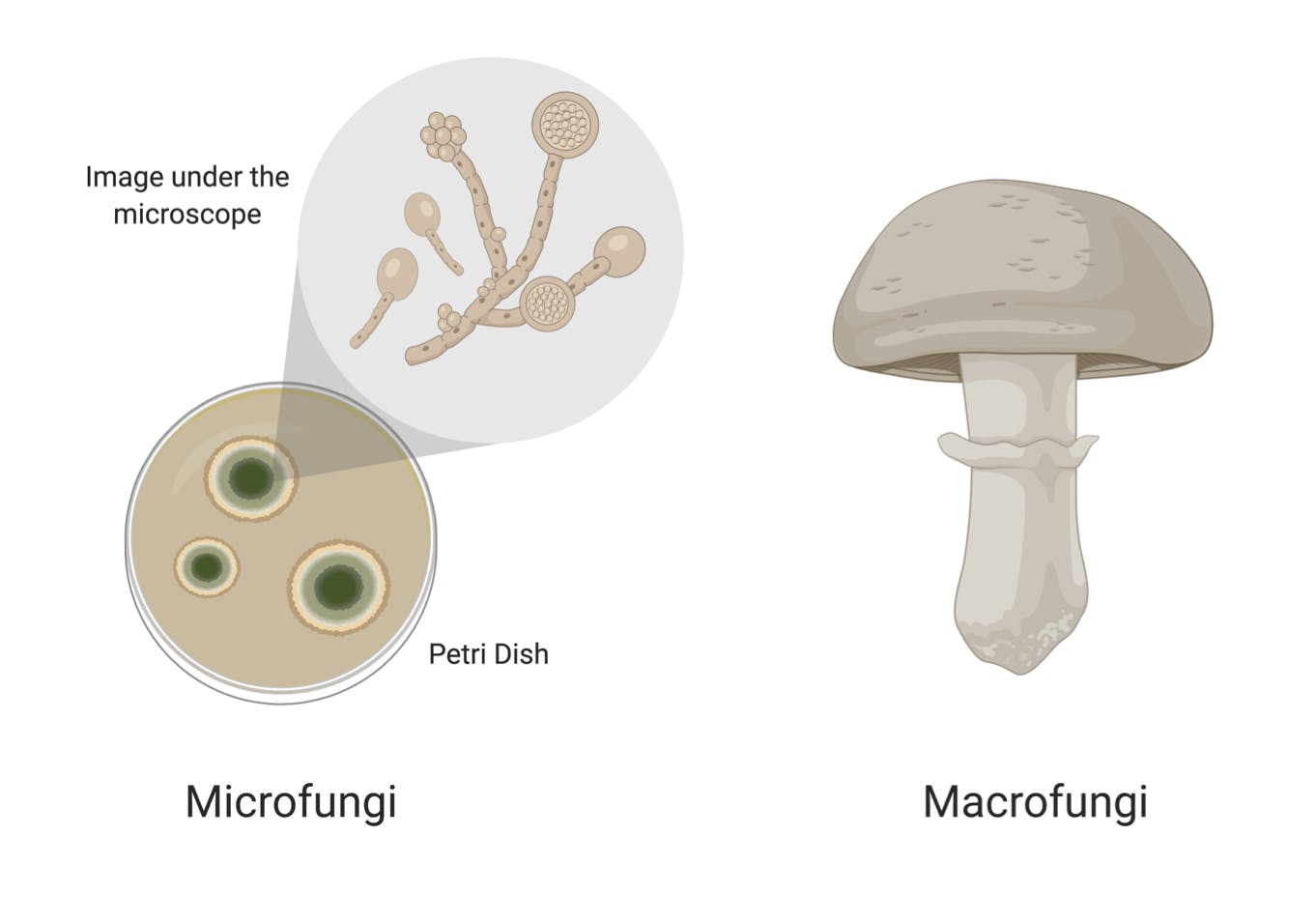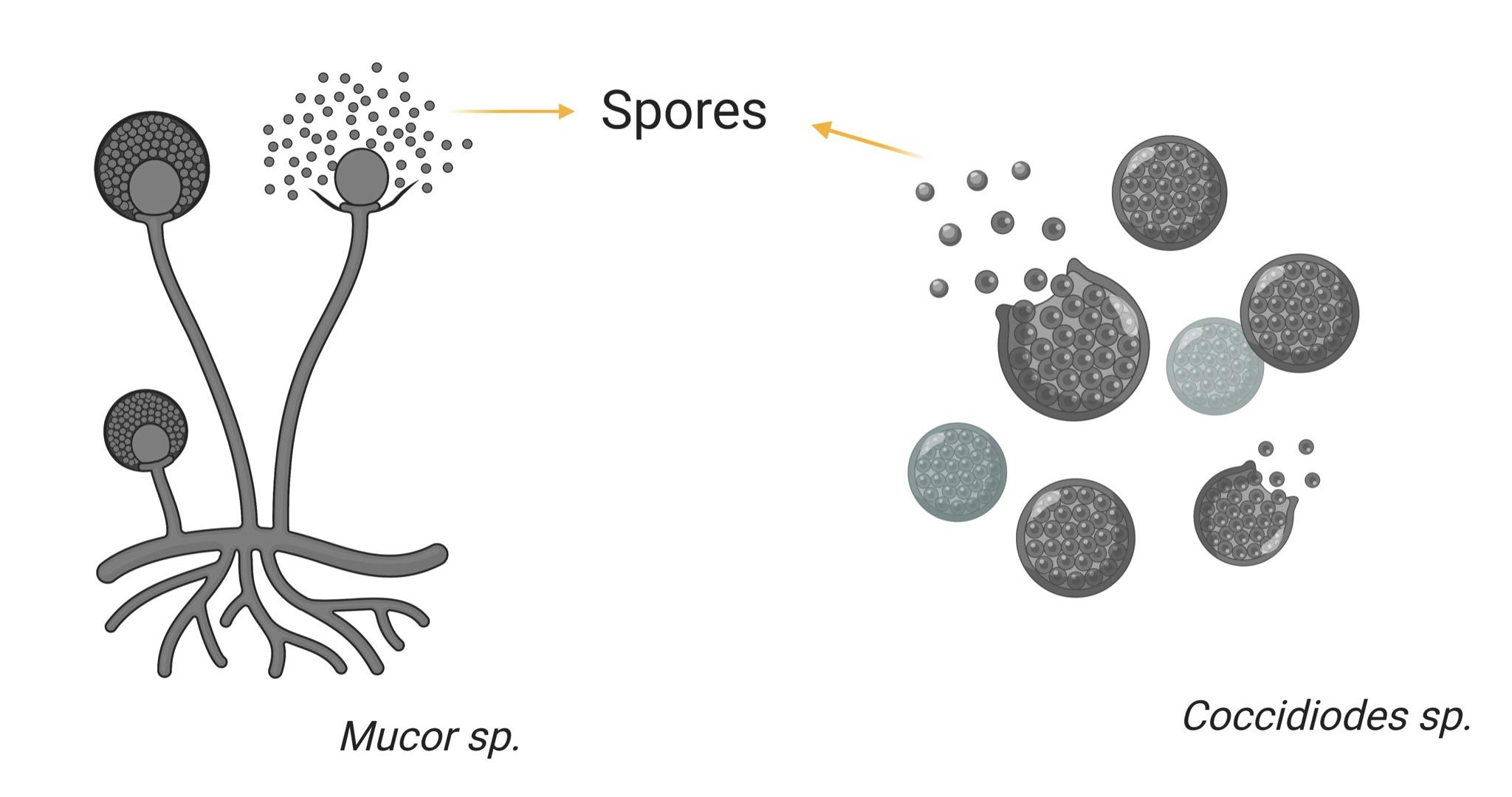Skip to content
KoBoToolbox definitions
 Fungi
Fungi
What are Microfungi?
Fungi includes microorganisms such as microfungi (yeasts and molds), as well as macrofungi such as mushrooms. Microfungi are an artificial, meaning that they are only distinguished from macrofungi by the absence of a large, multicellular fruiting body.
Macrofungi’s fruiting body or sporocarps is a multicellular structure on which spore-producing structures, such as or
, are born. The fruitbody is part of the sexual phase of a fungal life cycle, while the rest of the life cycle is characterized by vegetative mycelial growth and asexual spore production.

Graphical representation of types of fungus.
More information
Fungi
What are lichens?
A lichen, or lichenized fungus, is actually two main organisms functioning as a single stable unit. Lichens comprise a fungus living in a symbiotic relationship with an alga or cyanobacterium. There are about 17,000 species of lichen worldwide.
It’s important to remember that any association between a fungus and alga or cyanobacterium doesn’t automatically count as lichenization. In lichen associations, the fungus is able to form structures unknown in non-lichenized fungi (called the thallus) and the fungus also affects and changes the morphology of the photobiont. Hence, fungus-algal associations in which this is not the case are not considered lichens. Mosses are NOT lichens.
The fungal component of a lichen is known as the "mycobiont," and the algal or cyanobacterial component is known as the “photobiont.” The scientific name for a lichen is the same as that of the mycobiont, regardless of the identity of the photobiont.
More information:


Lichen genus from Colombia
Spore forming: Fungi spread either by forming reproductive spores that are carried on wind and rain or by growing and extending their hyphae. Hyphae are thread-like, strands of cells and grow as new cells form at the tips. A network of branching hyphae is called mycelium (plural mycelia).
Fungal spores are microscopic biological particles that allow fungi to be reproduced. They can be sexual or asexual. Most fungi require warmth and humidity to grow, reproduce and release their spores into the environment. Many fungi produce only small amounts of spores which rarely get airborne in quantity. However, some species are very prolific and widespread, producing high concentrations of spores which are readily dispersed into the atmosphere.
An example of spore forming microfungi are Mucor sp and Coccidiodes sp.


Spore forming fungi
In fungi and fungus-like organisms, spores are often classified by the structure in which meiosis and spore production occurs. Since fungi are often classified according to their spore-producing structures, these spores are often characteristic of a particular taxon of the fungi.
Pathogen: A fungi might be or become an infectious agent that can cause disease or illness to certain hosts. The host, meaning the organisms that harbors the microorganism in a symbiotic relationship, can be from plants, animals, fungi to humans. Sometimes an organism can be a pathogen of multiple hosts. Pathogenic fungus include Aspergillus sp., Cryptococcus sp., Histoplasma sp. among others.
More information about human fungi pathogens visit
Antimicrobial Resistance (AMR): AMR is the ability of a microbe to resist the effects of antimicrobials that once could successfully treat the microbe infection in humans, animals or plants. Antimicrobial resistance is a process that occurs naturally, but with the exacerbated use of antimicrobials due to human activities microbes have accelerated the rate of developing resistance. In Fungi AMR is also referred as Antifungal Resistance.
Extremophile: Microbes with optimal growth in environmental conditions considered extreme in comparison to the environmental conditions that are comfortable to humans such as low/high temperature, acidity, alkalinity, or chemical concentration. There are different types and degrees of extremophiles. They are not exclusive, meaning that a microbe can be for example an acidophile and thermophile.
There can be microbes that can be more extreme than others within the same extremophile type. For example: There could be slight halophiles that grow on 0.3 to 0.8 M, 1.7 to 4.8 % NaCl, moderate halophiles that grow on 0.8 to 3.4 M, 4.7 to 20 % NaCl and extreme halophiles that grow on 3.4 to 5.1 M, 20 to 30 % NaCl.
Some microbes might tolerate extreme conditions. However they do not do well under these conditions and their optimal conditions are within normal parameters (temperature, salinity, etc). Tolerant microbes are not considered extremophiles.


Table of different types of microbial extremophiles
Metabolism: Is the means by which the microbe obtains the energy and nutrients needed to live and reproduce. All microbial metabolisms can be arranged according to three principles: How the microbe obtains energy for living and growing; how the microbe obtain reducing equivalents used in energy conservation and biosynthetic reactions; and how the microbe obtains carbon for synthesizing cell mass.
(can add specifics about diatoms if needed)


Microbial metabolisms
Microbiome: Community of microbes living together in a particular habitat or host. Habitat could be water or soil biomes, and hosts could be from plants to humans. We have also included extreme biomes. Some microbes can live in multiple biomes.
Water biomes can be classified on:
Soil Biomes can be classified on:
Host Biomes can be classified on:
Extreme Biomes can be classified on:
Urban Environments: Referred to any urban, human-made setting. Example: Cities, laboratories, farms, reactors, etc.
Food: Referred to any type of food that can be consumed by humans or animals
Want to print your doc?
This is not the way.
This is not the way.

Try clicking the ⋯ next to your doc name or using a keyboard shortcut (
CtrlP
) instead.